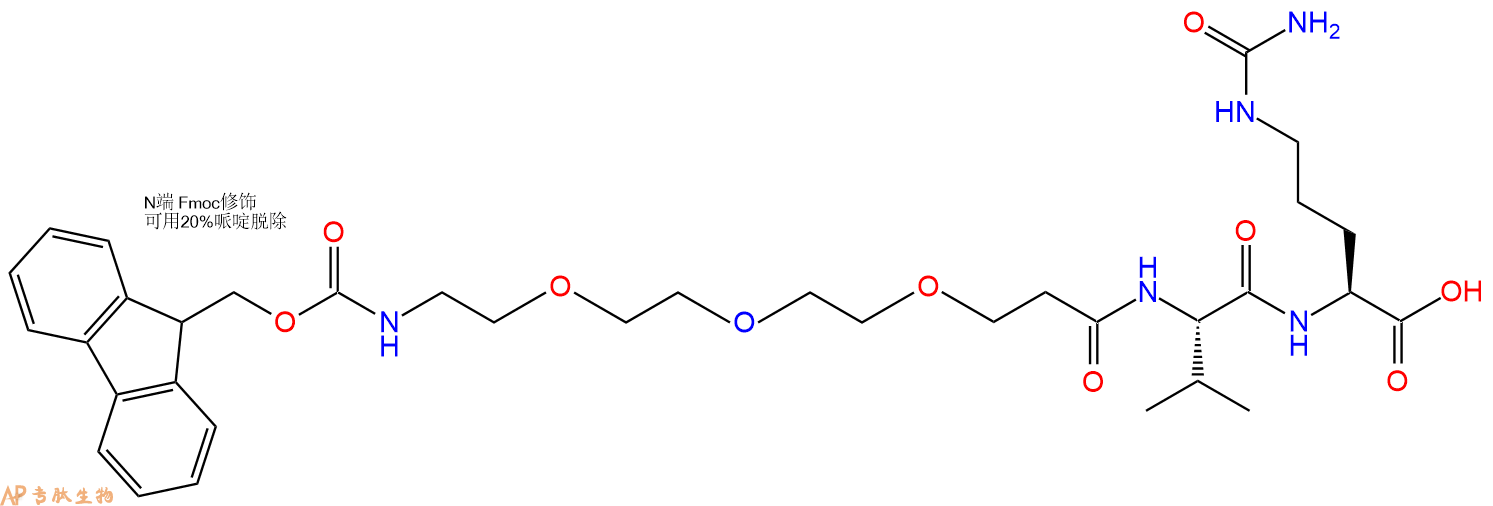400-998-5282
专注多肽 服务科研
400-998-5282
专注多肽 服务科研

Fmoc-PEG3-Val-Cit是含有Fmoc保护的胺和可酶切的Val-Cit基团的PEG连接体。亲水性PEG间隔物增加了在水性介质中的溶解度。
编号:436754
CAS号:
单字母:Fmoc-PEG3-CH2CH2CO-VCit
| 编号: | 436754 |
| 中文名称: | Fmoc-PEG3-Val-Cit |
| 英文名: | Fmoc-PEG3-Val-Cit |
| 单字母: | Fmoc-PEG3-CH2CH2CO-VCit |
| 三字母: | Fmoc N端Fmoc保护,9-芴甲氧羰基(Fmoc)是伯胺和仲胺的保护基团。在固相肽合成(SPPS)中,它是氨基酸主链的常用保护基,因为它可以很容易地用哌啶去除,而不会干扰树脂和肽之间的酸不稳定连接体。 -PEG暂无说明 -PEG暂无说明 -PEG暂无说明 -CH2CH2COPEG丙酸形式 -ValL-缬氨酸:valine。系统命名为(2S)-氨基-3-甲基丁酸。是编码氨基酸。是哺乳动物的必需氨基酸。符号:V,Val。在某些放线菌素如缬霉素中存在 D-缬氨酸。 -Cit瓜氨酸:citrulline。系统命名为(2S)-氨基-5-脲基戊酸。首先在西瓜汁中发现。L-瓜氨酸是动物体内氨基酸代谢、尿素循环中的重要中间物。L-瓜氨酸是一种α-氨基酸,由于翻译后修饰而存在于某些蛋白质中。血循环中的瓜氨酸是肠道功能状况的生物标志物。 -OHC端羧基:C-terminal carboxyl group。在肽或多肽链中含有游离羧基的氨基酸一端。在表示氨基酸序列时,通常将C端放在肽链的右边。 |
| 氨基酸个数: | 4 |
| 分子式: | C35H49O10N5 |
| 平均分子量: | 699.79 |
| 精确分子量: | 699.35 |
| 标签: | 氨基酸衍生物肽 |
Fmoc-PEG3-Val-Cit是含有Fmoc保护的胺和可酶切的Val-Cit基团的PEG连接体。亲水性PEG间隔物增加了在水性介质中的溶解度。Fmoc基团可以在碱性条件下脱保护以获得可用于进一步偶联的游离胺。Val-Cit被溶酶体蛋白水解酶有效切割,同时在人类血浆中高度稳定,这使其成为ADC接头设计中的一个潜在缺陷。
Fmoc-PEG3-Val-Cit is a PEG linker containing an Fmoc-protected amine and enzymatically cleavable Val-Cit group. The hydrophilic PEG spacer increases solubility in aqueous media. The Fmoc group can be deprotected under basic condition to obtain the free amine which can be used for further conjugations. The Val-Cit is effectively cleaved by lysosomal proteolytic enzymes while being highly stable in human plasma, making this a potentent stragy in ADC linker design





